|
|
 |
THE MYSTERY OF PYRAMIDS
|
|
|
|
HOW WERE PYRAMIDS BUILT?
The basic quantifiable mysteries are size, height, weight.
1. They are very big. The pyramid of Cheops measures about 140 meters,
weighs about 6.500.000 tons. The base makes 230 x 230 meters.
2. They are made of 2.5 (sic!) ton blocks.
3. The surface of blocks did not crack along layers after thousands of years of exposure to wind and sun.
4. The seams between blocks are very fine, about 1 mm.
"Classical" pyramid building know-how
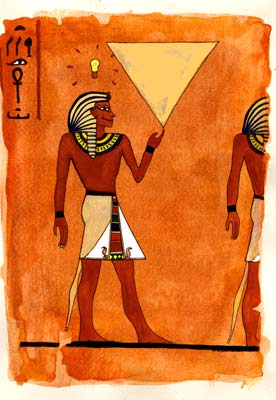
The history
and storybooks tell us that pyramids were built 3,4,5 thousand years
ago from whole stone monoliths, cut out from rock, transported on
considerable distances, somehow lifted and piled on each other with
incredible exactitude.
We are told that thousands upon thousands of slaves were toiling year
after year, century after century, millennium after millennium in
distant stone quarries, cutting monoliths in extra precise blocks of
2-3 tons and dragging them on sledges to the building sites. Some
mysterious, but highly efficient machines made of wood have been
lifting heavy bits and pieces higher and higher and positioning them
neatly.
Very ingenious very ancient Egyptians create the Wonder of the World!
Naturally, we learn that rubbish by heart when we are school kids and
visit and admire the artifacts when we are old and senile tourists.
Both ages love fairy tales.
No one could have built an edifice described in Articles 1-4 quoted
above neither in the distant past, nor in the far away future with
"technology" from history and storybooks.
SELF-MADE PYRAMID
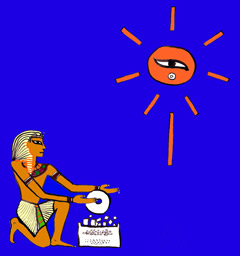
The pyramids are built from primitive low quality concrete as follows:
1. Grind lime into fine powder.
2. Dry it under scorching Egyptian sun.
3. Transport powder by horse, donkey, camel, slave or freeman power in bags to the building site.
4. Construct wooden casing box for your
first concrete block of pyramid.
5. Lay out your casing inside with mats.
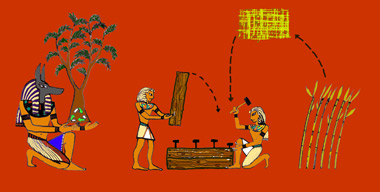 6. Remember wood is rare in Egypt and must be reused many times; primitive cane mats are abundant.
6. Remember wood is rare in Egypt and must be reused many times; primitive cane mats are abundant.
7. Transport water, sand, pebbles and small stones by horse, donkey, camel, slave or freeman power to the pyramid-building site.
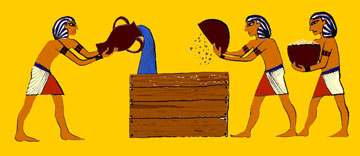 8. Fill casing with sand and small stones, pebbles, and bits of
calcium; add water, mix, and let concrete set under scorching sun.
8. Fill casing with sand and small stones, pebbles, and bits of
calcium; add water, mix, and let concrete set under scorching sun.
9. Dismantle your casing when concrete has in order to reuse every precious board for the casing of the next block.
10. Put a layer of lime on the top of every concrete block to separate blocks. Your pyramid must "breathe" in such hot climate.
11. Build wooden casing boxes for your consecutive second, third, …,
Nth concrete block from the boards of the casing of your first,
second…(N-1) block.
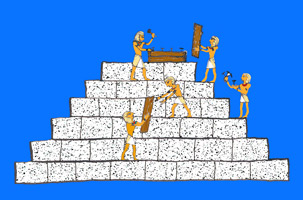 12. Repeat steps 4 to 9 till you reach the top of the pyramid. In order
to make your pyramid look gleaming white & sweet as old time
grand-grandmothers sugar cone proceed as follows:
12. Repeat steps 4 to 9 till you reach the top of the pyramid. In order
to make your pyramid look gleaming white & sweet as old time
grand-grandmothers sugar cone proceed as follows:
1. Go to the quarry and cut nice white limestone 0.5 - 2.5 plates and blocks.
2. Carry or drag them to the pyramid with sledges etc.
3. Cover your pyramid to make it white and shiny.
As a matter of fact old Herodotus describes this receipt fairly
closely. An early visitor to Egypt Frenchman Paul Lucas who visited
Egypt in 1699-1703 and 1714-1717 reported that the pyramids were made
from concrete.

If you still have doubts, fly to Egypt!
... and tell everybody that pyramids are made of primitive concrete.
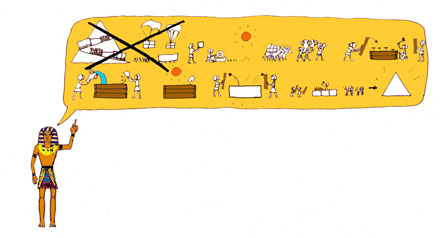
Today, we are still wondering how those gigantic stone building were
constructed. When Napoleon, the French emperor, came to Egypt, he tried
to calculate how many stone had been used to build the pyramids and he
concluded that they were enough stones in the pyramid to build a wall
around the French borders !

|
|
 |